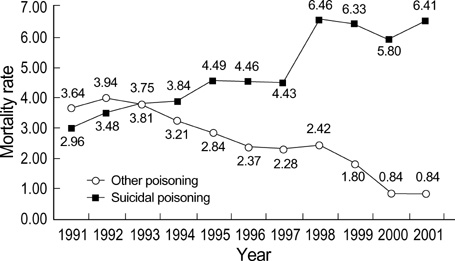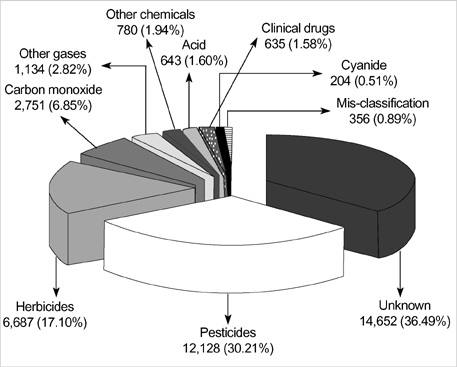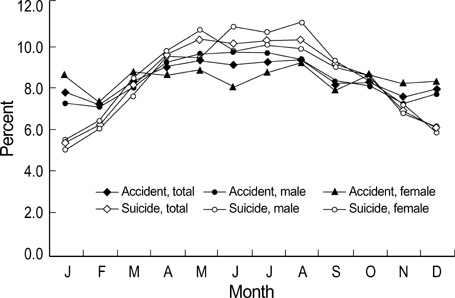Epidemiologic Characteristics of Death by Poisoning in 1991-2001 in Korea
- Affiliations
-
- 1Department of Emergency Medicine, Seoul National University College of Medicine, Seoul, Korea. suhgil@snu.ac.kr
- 2Department of Preventive Medicine, Kangwon National University Medical School, Chuncheon, Korea.
- 3Department of Genetics, Southwest Foundation for Biomedical Research, USA.
- 4Health Insurance Review Agency, Seoul, Korea.
- KMID: 1733475
- DOI: http://doi.org/10.3346/jkms.2004.19.2.186
Abstract
- The purpose of this study was to investigate the epidemiologic characteristics of the death by poisoning in Korea. We recoded the Death Certificates Database by injury based on the short version of the International Classification of External Causes of Injuries (ICECI). We evaluated the mortality rate by total injury and poisoning, and analyzed the mortality rate by age, gender, year and month, toxic agent, and intent. Adjusted odds ratios were calculated to evaluate the effects of socioeconomic factors on suicidal poisoning death. The total number of death cases by injury was 346,656. The proportion of death cases by injury decreased from 13.53% of all death cases in 1991 to 11.89% in 2001. However, the mortality rate by poisoning increased rapidly from 1998, and then remained stable. The number of suicidal poisoning deaths has gradually increased, and its mortality rate was 6.41 (per 100,000) in 2001. Major toxic agents were pesticides and herbicides (50.90%) in 2001. Adjusted odds ratios of suicidal poisoning versus other poisonings showed significant differences in education attainment, region, and marital status. In conclusion, the mortality rate by poisoning has increased, and the proportion of suicidal poisoning also has increased compared to that of accidental poisoning.
Keyword
MeSH Terms
Figure
Cited by 3 articles
-
Triage Method for Out-of-Hospital Poisoned Patients
Woon Yong Kwon, Joong Eui Rhee, Hong Seong Gang, Sang Do Shin, Jun Hwi Cho, Hyoung Gon Song, Gil Joon Suh
J Korean Med Sci. 2007;22(2):336-341. doi: 10.3346/jkms.2007.22.2.336.Necessity and the strategy to establish a national poison center in Korea: through needs survey analysis and database status for Chemical Accident Emergency Respond Information System
Kyung-Hee Kim, Dae-Jong Song, Mi-So Park, Yuon-Shin Park, Hae-Joon Kim, Jae-Wook Choi
J Korean Med Assoc. 2013;56(8):724-735. doi: 10.5124/jkma.2013.56.8.724.Suicidality and Its Risk Factors in Korean People with Epilepsy: A MEPSY Study
Jong-Geun Seo, Jang-Joon Lee, Yong Won Cho, Se-Jin Lee, Ji-Eun Kim, Hye-Jin Moon, Sung-Pa Park
J Clin Neurol. 2015;11(1):32-41. doi: 10.3988/jcn.2015.11.1.32.
Reference
-
1. WHO-Working group for Injury Surveillance Methodology Development and Its Technical Group. International Classification of External Causes of Injuries (ICECI). 1999. 06. Amsterdam: Consumer Safety Institute.2. Department of Health & Human Services Centers for Disease Control and Prevention National Center for Disease Prevention and Control. CDC's Short Version of the ICECI; A Pilot Test. 2000.3. Annest JL, Pogostin CL, Conn J, Fingerhut LA, Pickett D. Proposed short version of the International Classification of External Causes of Injuries (ICECI). Chapter 6. April 2000. In : Proceedings of the International Collaborative Effort on Injury Statistics, Vol III, 2nd Symposium; 1999 June; Washington (DC): Available at www.cdc.gov/nchs/about/otheract/ice/pro-iii.htm.
Article4. Korea National Statistical Office. Annual Report on the Cause of Death Statistics. 2002. Daejeon:5. Song KJ, Cho KH, Lee HS. Drug intoxication patients in the emergency department. J Korean Soc Emerg Med. 1992. 3:38–45.6. Lee JK, Park JH. Clinical observation of acute drug intoxication. J Korean Soc Emerg Med. 1993. 4:35–42.7. Hwang KM, Lee YC, Lee ST, Lee SR, Rhee YK. Clinical studies on acute drug intoxication. J Korean Soc Emerg Med. 1993. 4:43–52.8. Na BH, Oh DR, Hwang JI, Lim KW, Yu SJ, Park IY, Chun HM, Kim SK. The regional analysis of drug intoxication in emergency room. J Korean Soc Emerg Med. 1995. 6:107–183.9. ICE-ICD 10 Injury Mortality Framework-Overview and Implications. National Center for Health Statistics. Available at www.cdc.gov/nchs/about/otheract/ice/matrix10impl.htm.10. National Center for Health Statistics. Health, United States, 2000. 2000. Hyattsville, Maryland: Public Health Service.11. Hoppe-Roberts JM, Lloyd LM, Chyka PA. Poisoning mortality in the United States: comparison of National Mortality Statistics and Poison Control Center reports. Ann Emerg Med. 2000. 35:440–448.
Article12. Litovitz TL, Klein-Schwartz W, Rodgers GC Jr, Cobaugh DJ, Youniss J, Omslaer JC, May ME, Woolf AD, Benson BE. 2001 Annual report of the American Association of Poison Control Centers Toxic Exposure Surveillance System. Am J Emerg Med. 2002. 20:391–452.
Article13. Litovitz TL, Klein-Schwartz W, White S, Cobaugh DJ, Youniss J, Drab A, Benson BE. 1999 Annual report of the American Association of Poison Control Centers Toxic Exposure Surveillance System. Am J Emerg Med. 2000. 18:517–574.
Article14. Kreiger N, Williams DR, Moss NE. Measuring social class in US public health research: concepts, methodologies, and guidelines. Annu Rev Public Health. 1997. 18:341–378.
- Full Text Links
- Actions
-
Cited
- CITED
-
- Close
- Share
- Similar articles
-
- Epidemiologic Characteristics of Intentional Poisoning: Emergency Department Based Injury in-depth Surveillance During 2011–2015
- Strategies for Prevention of Food Poisoning
- Death by Hemorrhagic Enteritis due to Suspicious Mushroom Poisoning: A Case Report
- Understanding the status of acute poisoning patients who visited the emergency room in 2018: using sample in-depth survey data
- Death Following Colchicine Poisoning: A Case Report





